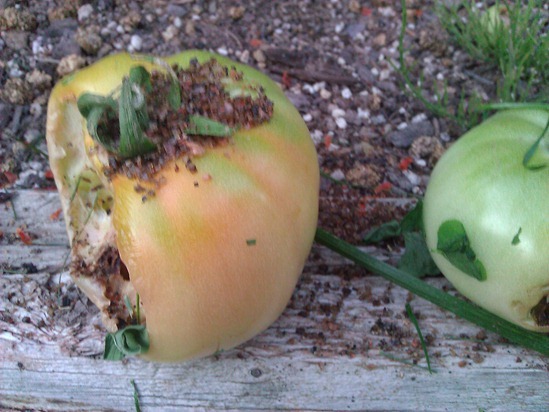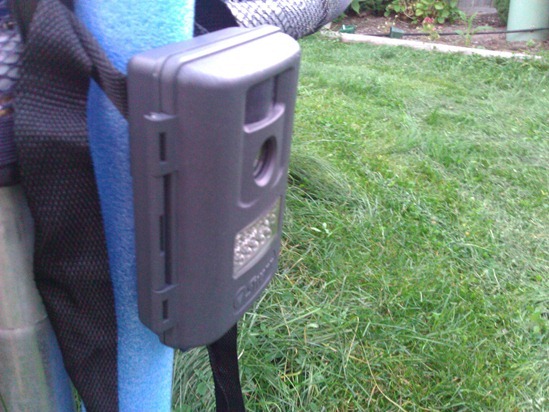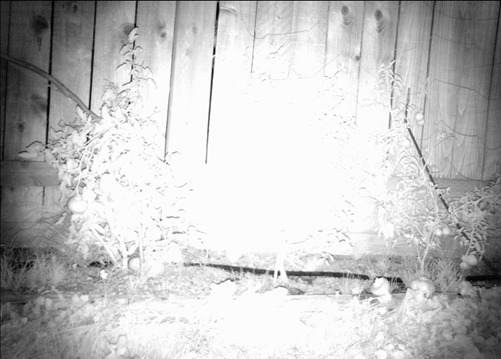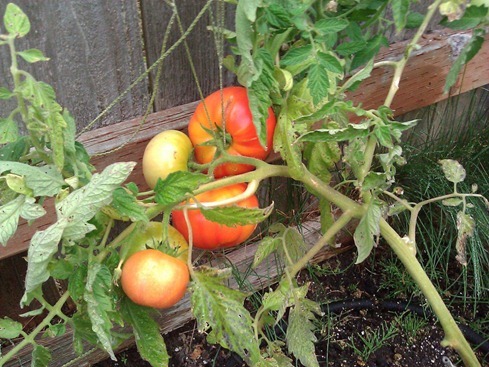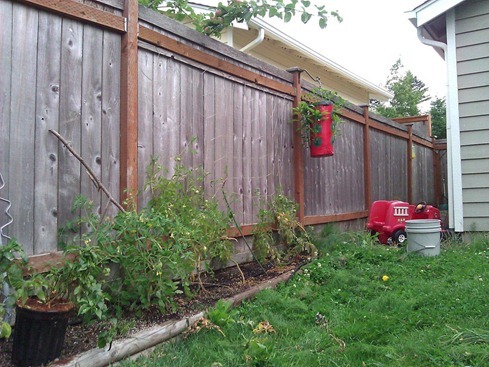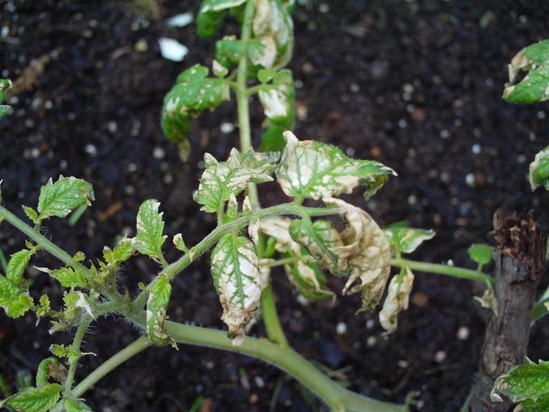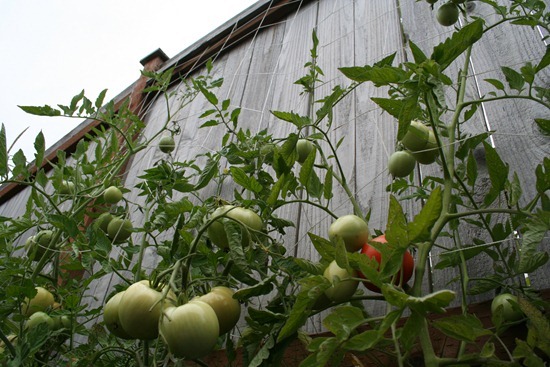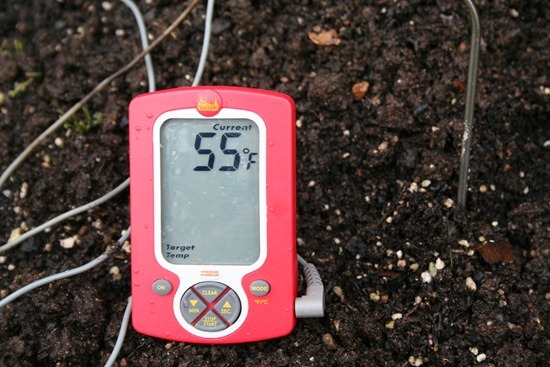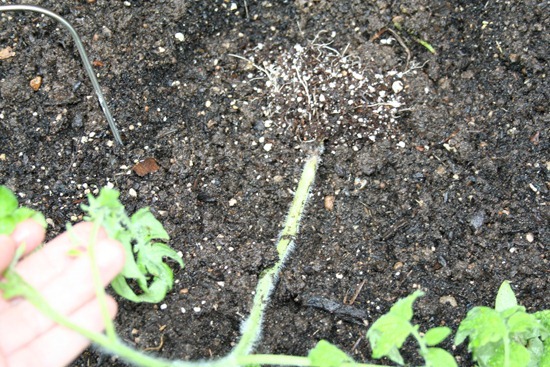Deterring mystery pest from eating my tomatoes: New Updates
12.7 years ago organic, pests, tomato
This is not the first time visitors have stolen tomatoes from my garden, but this year the mystery pest has gotten every ripe tomato I have grown this year, which given out cold/wet summer has only been about a dozen ripe tomatoes. I normally go with the philosophy of this land is owned by my neighborhood animals first and I am fine sharing a tomato, some lettuce, and a few blueberries, but with the end of the season coming closer and less tomatoes left on the vines…I am going to war with the hungry critter.
This evening I applied a liberal amount of Critter Ridder from Havahart following the directions on the packaging. Instead of trying to describe the product I will defer to marketing material to describe products I use since that is what they get paid the big bucks for.
This powerful combination of active, all-natural ingredients work together to irritate the animal immediately if it smells, tastes or touches the product. This unpleasant experience drives the animal away unharmed but unwilling to return to the treated area.
Our patented formula effectively repels groundhogs, skunks, dogs, cats, squirrels, raccoons, chipmunks and other nuisance animals.
So hoping my pest happens to one of the animals that hates the stuff. I applied this per the directions around my tomato beds and the lawn surrounding the bed. For good measure I also applied a little on a tomato they were too full to finish on their last visit. From previous observations I have found they are good about cleaning on the previous nights meal. Given the active ingredients contain black pepper oil and capsaicin (what makes peppers hot) given we are the only known species that will voluntarily eat these spices pretty sure the animal will not appreciate my seasoning of their leftovers from the previous night.

To once and for all confirm the pest I am dealing with I have setup my OutbackCam night camera to catch any returning visitors on film…hopefully I only catch them once after they have a taste of my spicy tomato I cooked up for them.
Nightly Updates
Night #1: Mystery pest returned, though moved the tomatoes around but did not eat much of his leftovers. Was a bit of a ninja and not captured on camera.
Night #2: Again the mystery pest returned and ate a little more but again did not trigger a picture
Night #3: Got a picture triggered but mystery pest must have some sort of invisibility cloak on because I do not see it in the picture. Planning on moving the camera back a little farther from the fence (or possibly turn on an outside light) since the IR LEDs seem to a little intense at that distance. Again the pest played with the tomatoes but didn’t seem to eat much (if any) and has not bothered any of the other tomatoes in the vine.
All About the Tomato Hornworm: From How to ID Them to Best Tomato Hornworm
12.8 years ago organic, pests, tomato
Tomato hornworms are common garden pests. This post will show you how to identify them and the best tomato hornworm control methods.
About the Tomato Hornworm
The tomato hornworm becomes the five-spotted hawk moth. In its caterpillar form, it is incredibly disastrous to gardens and landscapes.
How to ID the Tomato Hornworm
The tomato hornworm is 4-5 inches long, once full size. Typically they are the largest caterpillars you will see in your garden. Green in color it has white V-shaped marks. Their color and markings help camouflage them in your garden. In fact, you may see their destruction before you see the actual caterpillar.
Tomato hornworms have enormous appetites, destroying entire leaves, stems and immature fruits.
Given their name, many incorrectly assume they only attack tomatoes. However, they also attack eggplants, peppers and potatoes. In a matter of days they can completely defoliate a plant.
If you don’t recognize their damage or spot one, you can ID these vicious pests by their black droppings, called frass, found at the base of plants or on leaves.
How to Control Tomato Hornworms
One of the simplest ways to control tomato hornworms is to pick them off whenever you see them. They are large and easy to grab when you spot them. Either squish them or spray them with organic pesticides.
Handpicking, however, can be time-consuming. Only best for very small gardens, handpicking will ultimately leave behind some of the caterpillars. And because even just one caterpillar will cause extensive damage, handpicking is often not the most effective way to end their infestation.
Beneficial Insects
There are insects that eat the tomato hornworm, such as the praying mantis. However, beneficial insects may not be in your garden. If you add these beneficial insects, they will end up leaving for other food sources once they can’t find pests in your garden anymore. Thus, relying on them as your sole form of pest control gives the pests another chance of infestation.
Applying BT
BT, or Bacillus Thuringiensis, can be used to treat a tomato hornworm infestation. However, it only works on small larvae, leaving the plant-destroying adults behind to continue their extensive damage.
Best Organic Tomato Hornworm Control
They make really effective organic pesticide products. They are easy to use and kill the tomato hornworms at all stages, ensuring you a healthy organic garden.
Available as sprays and powders, the most effective ones:
· Kill 45 different insect species
· Exterminate them at all stages, from eggs to adults
· Are ready-to-use
· Are OMRI Listed, which means they’ve been reviewed and approved for use in organic gardening.
Guest Author Byline This guest blog post is written by Michelle Anderson who specializes in insect control, including organic pesticides and insect killer.
Go tomatoes go
12.8 years ago Pacific Northwest, tomato
I am a bit jealous seeing pictures across the country/world of everyone’s baskets of tomatoes, but I am getting close to my first few tomatoes on their modest vines starting to turn red…I see some salsa in my near future.
Tomatoland: How modern industrial agriculture destroyed our most alluring fruit review
12.8 years ago book, organic, product review, tomato
There is a very good reason why tomatoes are the most popular vegetable grown in the home garden, you can’t beat the taste of a home grown tomato. Tomatoland provides and exposé of specifically the Florida tomato industry showing many of the negative, though there are still a few positives explaining the history and the process of getting this previously alluring fruit to your local grocery store. After reading I can now add several other reasons to avoid purchasing those perfectly round and red commercial tomatoes at my local grocery store which I will explain in more details below.
Matter of Taste
As many of you may or not know below is what your delicious red tomato looks like when picked from the vine. By picking the tomatoes young this helps prevent fungal diseases prone to the humid Florida area where a good portion of our tomatoes from grocery stores and restaurants are grown. This also assists in the transportation of these tomatoes without damage to areas like where I live which is about far away from Florida as you can get. So how does these less appealing tomatoes look like the perfect ones we see in the stores? Once they reach their destination they are gassed with ethylene to give them their nice red appearance.
There have also been decades of breeding to produce a perfectly round, high yielding tomato, disease tolerant, and of proper size. Unfortunately during this process taste has not really been a consideration into this breading process. Along with taste tomatoes have lost much of the nutritional value they have had in the past. “According to analyses conducted by the U.S. Department of Agriculture, 100 grams of fresh tomato today has 30 percent less vitamin C, 30 percent less thiamin, 19 percent less niacin, and 62 percent less calcium. So you grandmother may have been correct telling you to eat your vegetables back in the day…sadly maybe this is no longer the case.
Human Factor
Most people are aware that insecticides and pesticides are used to grow most of our commercially produced produce. We have been told that end up on our fruits are so small that there is no risk to humans. This statement is definitely an easily arguable statement but in this book the author goes into great detail of the effects of these pesticides on the farm workers who were forced to go into fields too soon before application and in many cases pesticides actually being sprayed directly on the workers. As a result this led to many cases of reproductive issues with the farmers leading to many cases of abnormalities of children at birth as well as sickness and injuries, rashes during the immediate exposure.
The book also details the outright slavery existing in the Florida tomato fields as less than a decade ago. This is something that surprised me that I had not heard about this. There are also examples of modern day indentured servitude by offering an appealing wage but then extorting money from the workers for simple items such as water, “showers” (using a garden hose to rinse of pesticides, food, and premium rent at living quarters which normally would include sharing a small trailer with several other men.
Overall
Overall I thought Tomatoland was a great book and help reinforce my reasons for growing my own produce and supporting my local organic farmers. It also encouraged me to me aware of who’s hands my food my travel as I decide to make a purchase at my local grocery store. I would recommend this book to anyone who feels that paying a little extra for organic products is just too much to pay or anyone simply interested in how the tomato industry is run.
What’s wrong with this tomato plant?
13 years ago disease, pests, tomato
I have my best guess on this one, but can’t seem to find any pictures online that match this tomato problem. So to confirm what do you think the problem could be?
10 Tips for growing tomatoes in the Northwest
13 years ago alfalfa pellets, blight, blossom end rot, disease, fertilizer, indoor growbox, Pacific Northwest, tomato
Unfortunately we do not have no where near the preferred climate to grow tomatoes. We have extremely mild temperatures with summer maximum average high of 78°F and maximum average lows of 59°F. Take that with our very short window of consistent rain (bringing blight) tomato plants are lucky to even be surviving when planted in our area let alone have a tremendous yield, though with a little planning and care you can be eating delicious tomatoes from your garden.
1. Pick the right variety. You want to choose a plant that has has a low number of days to maturity. Given we have a very short growing season this can significantly improve your chances of growing some ripe red tomatoes. Some good examples of tomato varieties to try followed by the average days to maturity Early Girl (52), Goliath (60), Juliet (60), Oregon Spring (58), Sugary (62), or Sunsugar (62). You may also want to consider growing smaller tomato varieties such as cherry or globe which can be beneficial given the smaller the fruit the shorter amount of time is takes to ripen which could allow you to harvest your tomatoes before the rains along with the diseases.
2. Start with big plants. Paying a couple dollars more on your tomato plants can shave off a 2-3 weeks off your “days to maturity” number so go for the largest plant you can afford. On a budget (or just cheap like myself) plant your seeds early and make use of a greenhouse or grow box to make your own more mature tomato plants and save yourself a considerable amount of money. If you do purchase a larger plant, don’t be in a hurry to get it into the ground…let they nursery keep it alive for you until you have optimum environment to plant it in your garden.
3. Plant at the right time. Even more important that the air temperature is the temperature of the soil you can actually plant tomatoes with a soil temperature of 50°F but the closer you can get to 60°F the better your plants will respond. When it comes to measuring your soil temperature you can use a standard inexpensive soil thermometer but personally I just use my handy digital grill thermometer and if you are concerned about using the same probe in your meat than your dirt you can always pickup a extra temperature probe.
4. Work in the trenches. The temperature of the soil can vary by 5-10°F as you dig deeper into the soil. By planting your tomato plants in a trench no only do you get the benefits of a larger root but also a root system much closer to the surface of the soil which can provide several additional degrees to your advantage. One disadvantage to this method is you do need to be diligent with your watering due since the ground will obviously dry out on the area closest to the surface.
The process for planting trenched tomato plants is very simple. Dig a shallow trench about an inch lower than the root ball. Lay the plant on its side removing an stems that are about to be buried. Cover with soil and pack down lightly and use some sticks to help support the plants until they get adapted to their new orientation. Unless it is pouring down rain when you plant them like I did be sure to water your plants well after planting.
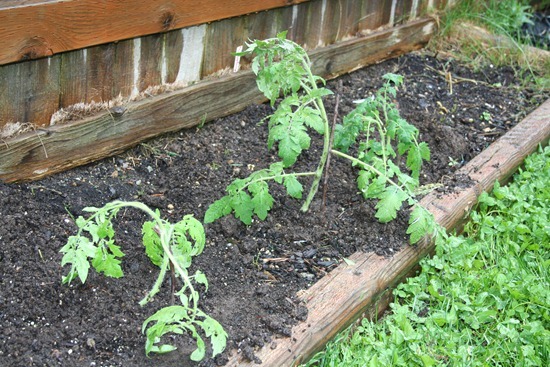
Note: I intentionally took the photo of these plants a few hours after planting to show the expected shock they should encounter…this is normal don’t be alarmed they will perk up in a day or two.
5. Keep your plants warm. As mentioned before the temperatures are almost ever warm enough but fortunately there are a few products to help out a little for this:
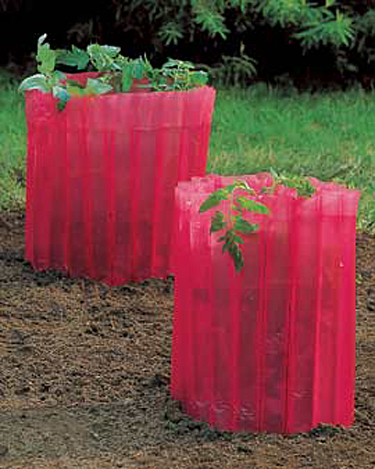 |
These Red Tomato Teepees are simply filled with water and absorb heat during the day and then slowly release it during the night and is advertised to help bring you yields up to 6 week earlier than without them. This provides more adequate temperatures for your plants and also some insurance for cold spring mornings. These are fairly inexpensive and can easily be collapsed and stored away when not needed. |
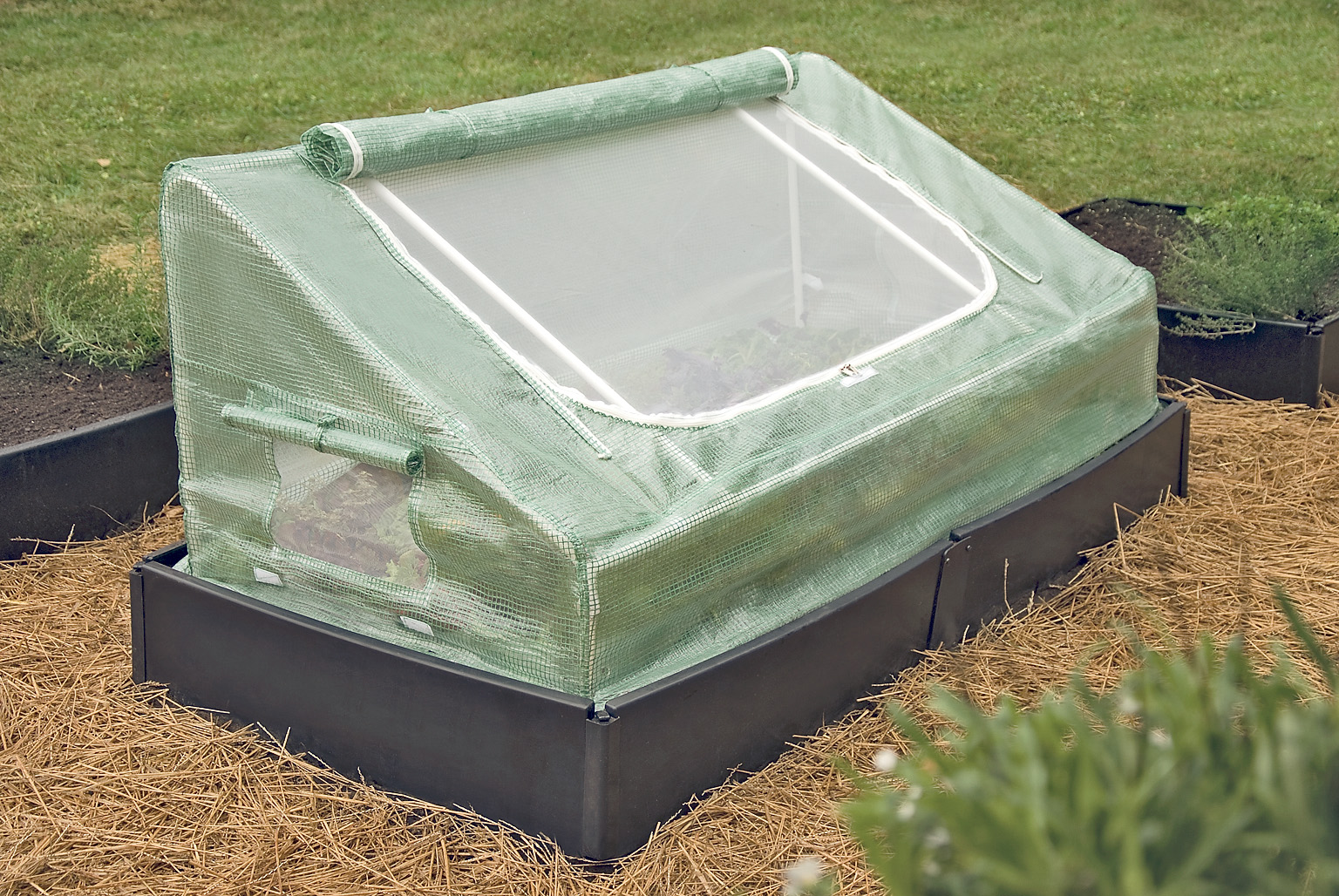 |
If you have a small number of plants to provide a little shelter you may want to consider a cold frame. These provide a few extra degrees of protecting during the cold nights but also protect the plants from high winds and hard rains. You can also use this as a little hot box for your peppers once your tomatoes are more established. |
 |
If you really want to go all out you can also consider soil warming cable this is simply a cable you bury into the ground and plug it in and will provide heat underground where the roots need it most. Now I will be the first to admit this may be more of an extreme measure for your tomato plants but if you are considering growing crops all year round this could be a good investment. |
6. Grow your tomatoes in upside down planters. One of the advantages of growing tomatoes upside down is the planter is exposed to the heat from the sun thus increasing the soils temperature providing better temperatures for the roots of your tomato plants to grow. Now whether you opt to make your own upside down planter or use one of the commercial versions such as the TopsyTurvy, this can be a great way to sneak your plants out at least a couple of weeks earlier.
7. Don’t let your tomato plants get wet. Living in the Northwest, rain happens and there is not much we can do about it. This moisture can spread disease and promote fungal growth so the less moisture you can get on your plants leaves the better. There are a few things you can do to reduce the amount of moisture on your plants. First, when watering your plants avoid getting water on the leaves. Simply water the soil right at the surface, this can be easily done with a soaker hose, long wand spray nozzle, or even a simple watering can. If you are experiencing some hard rains at the end of your season you may be able to delay blight by installing a slight overhang over your tomato plants. By taking some rigid clear plastic and installing over your plants you can reduce the amount of rain that falls directly on your plants while not inhibiting light getting to your plants.
8. Fertilize. Providing the right nutrients to the plants as they need them can help encourage their growth and provide vigorous plants in the shorter period of time. The problem with tomatoes is if you over fertilize your plants will simply grow larger and fail to produce fruit as can be seen from this tomato plant I had growing out of my compost bin.
I provide a weak balanced fertilizer such as alfalfa pellet applied every couple weeks to the top of the soil allowing them to break down and provide nutrients on each watering.
Once the plant begins to set flowers I switch to applying about a 1/4 cup of bone meal to each of the plants about every 3 weeks to allow the plants to get the phosphorous they need during for reproductive function at this this time.
9. Many plants with less tomatoes. The less tomatoes your plants has ripening on its vines the more energy it has to get them to that nice delicious red color for picking. By pinching off all the suckers not on the main vine you will get your tomatoes to ripen more quickly while taking less space. By doing this I can plant my tomatoes 18-24” apart allowing me to get a few extra plants in to make up for some of this lost yield ending up with less green tomatoes at the end of the season.
10. Get supermarket quality tomatoes from your garden. Of course tomatoes ripened on the vine will have the better taste but when your season runs out and your tomatoes are still green what can you do? One option is to take any flawless tomatoes (no bruises, no cracks) place them very gently in a cardboard box padded on bottom with newspaper and place in a cool humid location. You may also add a ripe banana to speed up the process by adding a little extra ethylene. If you are luck in a couple/few weeks you should have some red tomatoes.
